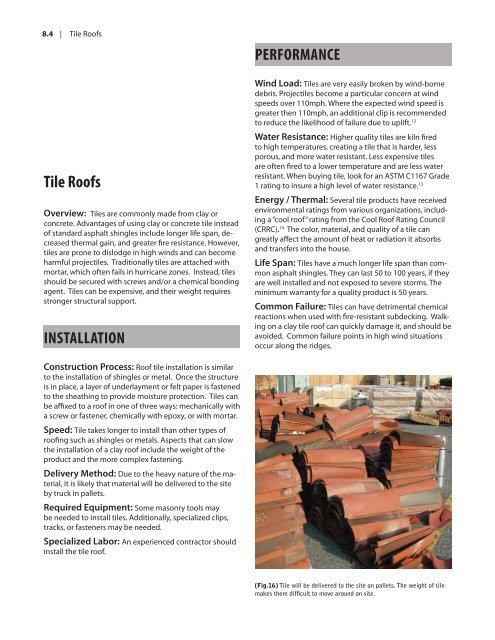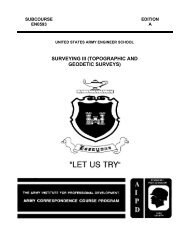Alternative Construction Research Guide - GCCDS
Alternative Construction Research Guide - GCCDS
Alternative Construction Research Guide - GCCDS
You also want an ePaper? Increase the reach of your titles
YUMPU automatically turns print PDFs into web optimized ePapers that Google loves.
8.4 | Tile RoofsPERFORMANCETile RoofsOverview: Tiles are commonly made from clay orconcrete. Advantages of using clay or concrete tile insteadof standard asphalt shingles include longer life span, decreasedthermal gain, and greater fire resistance. However,tiles are prone to dislodge in high winds and can becomeharmful projectiles. Traditionally tiles are attached withmortar, which often fails in hurricane zones. Instead, tilesshould be secured with screws and/or a chemical bondingagent. Tiles can be expensive, and their weight requiresstronger structural support.INSTALLATIONWind Load: Tiles are very easily broken by wind-bornedebris. Projectiles become a particular concern at windspeeds over 110mph. Where the expected wind speed isgreater then 110mph, an additional clip is recommendedto reduce the likelihood of failure due to uplift. 12Water Resistance: Higher quality tiles are kiln firedto high temperatures, creating a tile that is harder, lessporous, and more water resistant. Less expensive tilesare often fired to a lower temperature and are less waterresistant. When buying tile, look for an ASTM C1167 Grade1 rating to insure a high level of water resistance. 13Energy / Thermal: Several tile products have receivedenvironmental ratings from various organizations, includinga “cool roof” rating from the Cool Roof Rating Council(CRRC). 14 The color, material, and quality of a tile cangreatly affect the amount of heat or radiation it absorbsand transfers into the house.Life Span: Tiles have a much longer life span than commonasphalt shingles. They can last 50 to 100 years, if theyare well installed and not exposed to severe storms. Theminimum warranty for a quality product is 50 years.Common Failure: Tiles can have detrimental chemicalreactions when used with fire-resistant subdecking. Walkingon a clay tile roof can quickly damage it, and should beavoided. Common failure points in high wind situationsoccur along the ridges.<strong>Construction</strong> Process: Roof tile installation is similarto the installation of shingles or metal. Once the structureis in place, a layer of underlayment or felt paper is fastenedto the sheathing to provide moisture protection. Tiles canbe affixed to a roof in one of three ways: mechanically witha screw or fastener, chemically with epoxy, or with mortar.Speed: Tile takes longer to install than other types ofroofing such as shingles or metals. Aspects that can slowthe installation of a clay roof include the weight of theproduct and the more complex fastening.Delivery Method: Due to the heavy nature of the material,it is likely that material will be delivered to the siteby truck in pallets.Required Equipment: Some masonry tools maybe needed to install tiles. Additionally, specialized clips,tracks, or fasteners may be needed.Specialized Labor: An experienced contractor shouldinstall the tile roof.(Fig.16) Tile will be delivered to the site on pallets. The weight of tilemakes them difficult to move around on site.
















